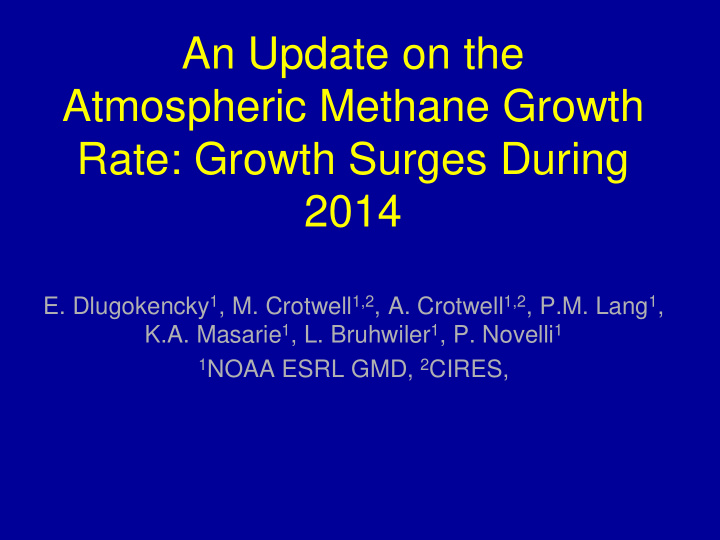



An Update on the Atmospheric Methane Growth Rate: Growth Surges During 2014 E. Dlugokencky 1 , M. Crotwell 1,2 , A. Crotwell 1,2 , P.M. Lang 1 , K.A. Masarie 1 , L. Bruhwiler 1 , P. Novelli 1 1 NOAA ESRL GMD, 2 CIRES,
Lifetime ≈ 9.3 yr [CH 4 ](t) = [CH 4 ] ss -([CH 4 ] ss -[CH 4 ] 0 )e -t/ τ
Emissions = d[CH 4 ]/dt + [CH 4 ]/ τ Lifetime ( τ ) = 9.1 yr Trend = 0 ± 0.6 Tg CH 4 yr -1 Average Emissions = 550 ± 13 Tg CH 4
Trend - SS
Globally averaged CH 4 and δ 13 C(CH 4 ) Sylvia Michel, INSTAAR
Base: 1961-1990 La Niña El Niño Australian BoM
Conclusions • Constant global emissions: 1984-2006 – Emissions from some sectors changing – Changes in WL emissions may have masked increased anthropogenic emissions • Increased GR and emissions since 2007 – Changes in tropical precipitation (ENSO) • Caused sea level to measurably decrease – δ 13 C (CH 4 ) indicates microbial source • 2014: CH 4 GR surged (~11 ppb) – Globally warm, but reasons unclear
Base: 1961-1990
Possible changes to CH 4 emissions • Rice: changing water management ↓ • FF sector: decreased venting and flaring ↓ • Emissions mitigation: M2M ↓ • FF emissions: hydraulic fracturing ↑ • Arctic permafrost and hydrates ↑
Global CH 4 Budget by Source Source Bousquet (Tg/yr) IPCC Range (Tg/yr) Anthropogenic Energy 110±13 74-106 Enteric fermentation 90±14 76-92 Rice agriculture 31±5 31-112 Biomass burning 50±8 14-88 Waste 55±11 35-69 Natural Wetlands 147±15 100-231 Termites 23±4 20-29 Oceans 19±6 4-15 Total 525±8 503-610 Sinks Bousquet (Tg/yr) IPCC (Tg/yr) Troposphere 448±1 428-511 Stratosphere 37±1 30-45 Soil 21±3 26-34 Total 506 492-581 Bousquet et al., 2006, Nature , 443 , 439-443, doi:10.1038/nature05132.
Recommend
More recommend